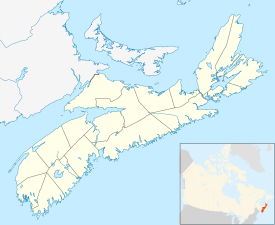
The Annapolis Valley is a valley and region in the province of Nova Scotia, Canada. It is located in the western part of the Nova Scotia peninsula, formed by a trough between two parallel mountain ranges along the shore of the Bay of Fundy. Statistics Canada defines the Annapolis Valley as an economic region, composed of Annapolis County, Kings County, and Hants County.
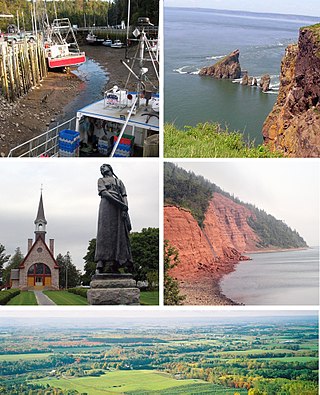
Kings County is a county in the Canadian province of Nova Scotia. With a population of 62,914 in the 2021 Census, Kings County is the third most populous county in the province. It is located in central Nova Scotia on the shore of the Bay of Fundy, with its northeastern part forming the western shore of the Minas Basin.

Middleton is a town in Annapolis County, Nova Scotia, Canada. Situated on the north bank of the Annapolis River, it is located close to the centre of the Annapolis Valley, from which it gets its nickname, "The Heart of the Valley".

Annapolis is a provincial electoral district in Nova Scotia, Canada, that elects one member of the Nova Scotia House of Assembly.

Grand-Pré is a Canadian rural community in Kings County, Nova Scotia. Its French name translates to "Great/Large Meadow" and the community lies at the eastern edge of the Annapolis Valley several kilometres east of the town of Wolfville on a peninsula jutting into the Minas Basin surrounded by extensive dyked farm fields, framed by the Gaspereau and Cornwallis Rivers. The community was made famous by Henry Wadsworth Longfellow's poem Evangeline and is today home to the Grand-Pré National Historic Site. On June 30, 2012, the Landscape of Grand-Pré was named a World Heritage Site by UNESCO.

The Annapolis River is a Canadian river located in Nova Scotia's Annapolis Valley.

The New England Planters were settlers from the New England colonies who responded to invitations by the lieutenant governor of Nova Scotia, Charles Lawrence, to settle lands left vacant by the Bay of Fundy Campaign (1755) of the Acadian Expulsion.

Trunk 1 is part of the Canadian province of Nova Scotia's system of Trunk Highways.

Berwick is a Canadian town in Kings County, Nova Scotia. The town is located in the eastern part of the Annapolis Valley on the Cornwallis River. The town site stretches south from the river and Exit 15 of Highway 101 to Highway 1. Berwick occupies 6.80 km2 and has an elevation of 43 m (141 ft) above sea level.
Cambridge is a community on the Cornwallis River in Kings County, Nova Scotia, Canada, located 12 kilometres west of Kentville. It is administratively part of the village of Cornwallis Square. According to one source, the community was named after Cambridge, England. while another holds it was named for Cambridge, Massachusetts.
The Evangeline Trail is a scenic roadway in the Canadian province of Nova Scotia.

The Oaklawn Farm Zoo is a zoo located in Millville, Nova Scotia, Canada, just south of the village of Aylesford. It was opened in 1984, and is family-owned and operated by Ron and Gail Rogerson. The zoo boasts the largest display of Big Cats and Primates in Eastern Canada. The 50-acre (20 ha) zoo is in a rural setting in Nova Scotia's Annapolis Valley, and includes a wide diversity of mammals, birds and reptiles.

The Cornwallis River is in Kings County, Nova Scotia, Canada. It has a meander length of approximately 48 kilometres (30 mi) through eastern Kings County, from its source on the North Mountain at Grafton to its mouth near Wolfville on the Minas Basin. The lower portion of the river beginning at Kentville is tidal and there are extensive tidal marshes in the lower reaches. In its upper watershed at Berwick, the river draws on the Caribou Bog while a longer branch continues to the official source, a stream on the North Mountain at Grafton.
Hall's Harbour is a fishing community in the Canadian province of Nova Scotia, located in Kings County on the North Mountain along the shore of the Bay of Fundy.
Wilmot is an unincorporated community located in Annapolis County in the Canadian province of Nova Scotia.
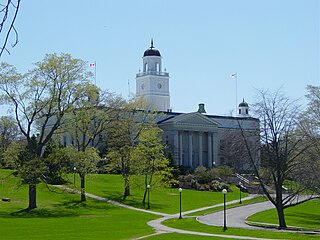
Leslie Raymond Fairn was a Canadian architect whose career is notable for its longevity and for the range of styles it encompassed, including Beaux Arts and Modernism. Most of his work was completed in the Maritimes.

Emma Maitland Stirling was a British activist in child welfare and in arranging their emigration to Canada. She created the organisation that became the Scottish Society for the Prevention of Cruelty to Children, but her contribution was not acknowledged in their history.

A township in Nova Scotia, Canada, was an early form of land division and local administration during British colonial settlement in the 18th century. They were created as a means of populating the colony with people loyal to British rule. They were typically rural or wilderness areas of around 100,000 acres (400 km2) that would eventually include several villages or towns. Some townships, but not all, returned a member to the General Assembly of Nova Scotia; others were represented by the members from the county. Townships became obsolete by 1879 by which time towns and counties had become incorporated.
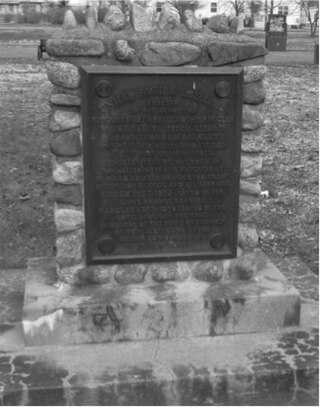
Lieutenant Colonel Samuel Vetch Bayard was a Loyalist military officer in the American Revolution who served in the King's Orange Rangers (KOR). He is the son of William Bayard who founded the KOR. He was the great-grandson of Governor Samuel Vetch and was the father of Robert Bayard.
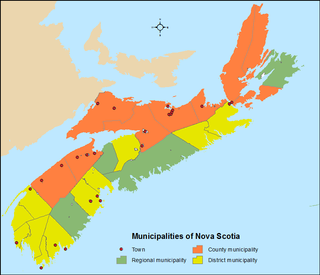
The Canadian province of Nova Scotia is divided into 49 municipalities, of which there are three types: regional (4), town (25), and county or district municipality (20).
